Agricultural Literacy Curriculum Matrix
Lesson Plan
Hen House Engineering (Grades 9-12)
Grade Level
Purpose
Students use the Claim, Evidence, and Reasoning model to evaluate styles of housing used for hens that lay eggs. Using critical thinking and scientific investigation skills, students will compare housing styles, determine which system meets their animal welfare standards, and engineer their own hen house model to meet the needs of laying hens. This lesson covers a socioscientific issue and aims to provide students with tools to evaluate science within the context of social and economic points of view. Grades 9-12
Estimated Time
Materials Needed
Engage
- Image of egg cartons or 1 dozen conventional, free range, and cage-free eggs
Activity 1: Examining Hen Housing Systems
- Claim, Evidence, and Reasoning in Egg Production handout, 1 per student
- Virtual Egg Farm Tour Videos:
Activity 2: Critically Thinking Animal Welfare
- Critically Thinking Animal Welfare PowerPoint
- Save your own copy of this slide deck
- Digital access for each student to the CSES Final Research Results Report OR a hard-copy of pages 26-35 of the report for each pair of students.
Activity 3: Design a Hen Housing System
- Stage 1:
- Hen House Engineering activity sheet, 1 per student
- Stage 2:
- Cardboard
- Clear packing tape
- Scissors (strong enough to cut cardboard)
- Various art supplies: markers, scrap paper or cardstock, etc.
- Stage 3: Optional
- See Introduction to Circuits activity
- Stage 4:
- Copper tape*
- White LEDs*
- 3V coin cell batteries*
- Hobby motor and propeller*
- Transparent tape
*These items are included in the Hen House Prototype kit, which is available from agclassroomstore.com
- Stage 5:
- Arduino Microcontroller - Programmed with Arduino*
- Breadboard*
- Arduino and Breadboard Holder* (optional)
- USB Mini-B Cable*
- Arduino power supply (wall adapter power supply or 9V battery holder)*
- Jumper wires*
- Jumper wires with alligator clips*
- Screwdriver*
- Craft knife
- Wire Stripper/Cutter/Crimping Tool
- Computer (Windows, Mac OS X or Linux)
- Arduino Software
*These items are included in the Arduino Microcontroller kit, which is available from agclassroomstore.com
Vocabulary
critical thinking: the objective analysis and evaluation of an issue in order to form a judgement
mortality: death or loss of life
selective breeding: process by which humans control the breeding of plants or animals in order to exhibit or eliminate a particular characteristic
Did You Know?
- The top 3 egg producing states in the U.S. are Iowa, Ohio, and Indiana.1
- The majority of all laying hens (76.4%) are housed in conventional barn systems, 17.8% are housed in cage-free systems, and 5.8% are part of certified organic farms.2
- The most economical egg to purchase at the grocery store is a conventionally-produced egg. Eggs produced in organic, free-range, or cage-free systems cost more due to higher production costs.3
Background Agricultural Connections
Modern Egg Production Practices
Eggs are laid by all types of birds, but chicken eggs are the most consumed egg. Chickens are cost-efficient to raise and can produce approximately one egg per day during their peak production. Eggs shells can be white, brown (light or dark), and even a light shade of green or blue. The shell color is determined by the breed of the chicken laying the egg. White hens have white earlobes and lay white-shelled eggs. Hens with red feathers and red earlobes lay brown-shelled eggs. White-shelled eggs are most common in the United States because White Leghorns are the most common breed of chicken to raise for egg laying due to their egg producing capacity and their smaller size when compared to other breeds of chickens. It is common for brown-shelled eggs to cost more than white eggs. It costs farmers more to produce brown-shelled eggs due to the size difference in the hens. Larger hens require more feed, but don't produce more eggs.
On egg farms, several types of hen housing systems are used. These systems include conventional style barns, cage free, free range, and enriched colony housing. Common to each system is continuous access to feed, water, and fresh air. All eggs, regardless of the type of farm they were produced on, provide the same level of nutrients to our diet.4 Egg farming has changed through the years as farmers have sought to produce a safe, nutrient rich, and economical food product for consumers.
History of Egg Farming5
In the 1920s and 1930s, egg farms were still mostly backyard systems. Many farmers had laying hens to supply their own families with eggs and would sell any extra eggs at local farmers’ markets. As selling eggs became profitable, some farms started building up flocks of about 400 hens. The hens roamed around outside with a coop for roosting. Living outside presented some problems, mainly with weather and predators. Social issues within the flock such as the “pecking order” were also a problem because bigger and more aggressive hens would eat more of the food, leaving less for the other hens. Disease transmission was also a problem. In the early 1900s, hens were laying about 150 eggs per year and had a mortality rate of about 40 percent. As the industry began to grow, selective breeding and new animal husbandry practices helped to cultivate healthier flocks. The strongest, healthiest hens with good egg-laying records were chosen by hatcheries to be parents. These parents passed along favorable genetic factors, such as disease resistance, to their offspring.
Research on moving hens to indoor living showed many benefits. While they were expensive, specialized large hen houses resulted in much healthier hens. When living indoors, the hens weren’t exposed to predators and the elements, including temperature extremes. Indoor housing also helped to prevent parasite infestations and reduce the spread of diseases from outside carriers such as rodents and even humans. Instead of the hens eating whatever they found outside, feed could be better controlled indoors. Better feeding practices improved both hen health and egg productivity. These changes reduced hen mortality to 18 percent per year.
In the late 1940s, some poultry researchers had favorable results with raised wire-floor housing for hens. The separated wire housing came to be called the conventional system. Sanitation greatly improved when hens were raised off the floor. Neither the hens nor the eggs came into contact with waste, and waste removal was much easier. Feeding became more uniform as the more timid hens were able to eat and drink as much as they required, just like the more aggressive hens. This resulted in more uniform egg-nutrient quality and less feed being needed for the flock.
The scientific research on conventional housing proved itself. A healthy hen will lay a lot of eggs. With much improved health, hens each produced about 250 eggs per year and their mortality dropped to 5 percent. Based on these numbers, more and more farms across the country built new facilities with the conventional style of housing. Improving the health of hens through more protective housing and better feeding facilities led to more eggs which led to increased automation to handle the eggs. With increased automation, labor costs were reduced, providing a lower cost to the consumer. In addition to much improved hen health, equal opportunity feeding also made the nutrient quality of eggs more uniform.
Animal Welfare in Laying Hens
From the early to the late 1900s, the egg laying industry changed from backyard chicken flocks to large scale, highly sophisticated operations. Decades of research through the 1900s led to what is known as conventional-style hen housing. Although the conventional system was developed using research to diminish the occurrence of disease, improve egg production and overall health of hens, and protect flocks from predators, this style of hen housing has faced some scrutiny. Alternative hen housing styles have emerged and are marketed using specific labels on egg cartons. This lesson provides students with the opportunity to use critical thinking skills to evaluate hen housing systems and consider different aspects of animal welfare.
Engage
- Display the image of egg cartons representing three styles of hen housing—conventional, cage-free, and free range.
- Tip: To make this activity more tangible, bring the actual egg cartons to class from your local grocery store. Let the students see the actual eggs and cartons for the discussion and comparison.
- Ask students, "What is different about these three egg cartons?" Allow students time to examine the cartons and the labels on each. If necessary, use guiding questions for students to conclude that one carton is labeled "Cage Free," another is labeled "Free Range," and the last does not indicate a specific type of farm where the eggs originated.
- Ask students, "What is the same about the eggs in these three cartons?" Students may identify several points including quantity, grade, size, color, and nutrition content.
- Summarize that the eggs in these three cartons are equally valuable in nutrition. Eggs are a good or excellent source of eight essential nutrients including protein and choline.
- Ask students, "If the actual eggs inside the carton are the same, why are there different labels to indicate the type of farm the eggs were produced on?" As students offer answers, lead a class discussion to identify their prior knowledge and conceptions about egg production practices.
- Explain that before the mid 2000s, we didn't see this variation in egg farming practices. Refer back to the egg carton image. Explain that the eggs in the top carton were laid by hens who live in a housing system that includes cages, the middle eggs were from a cage-free hen house, and the bottom carton of eggs (free range) are from a housing system where the hens have access to the outdoors.
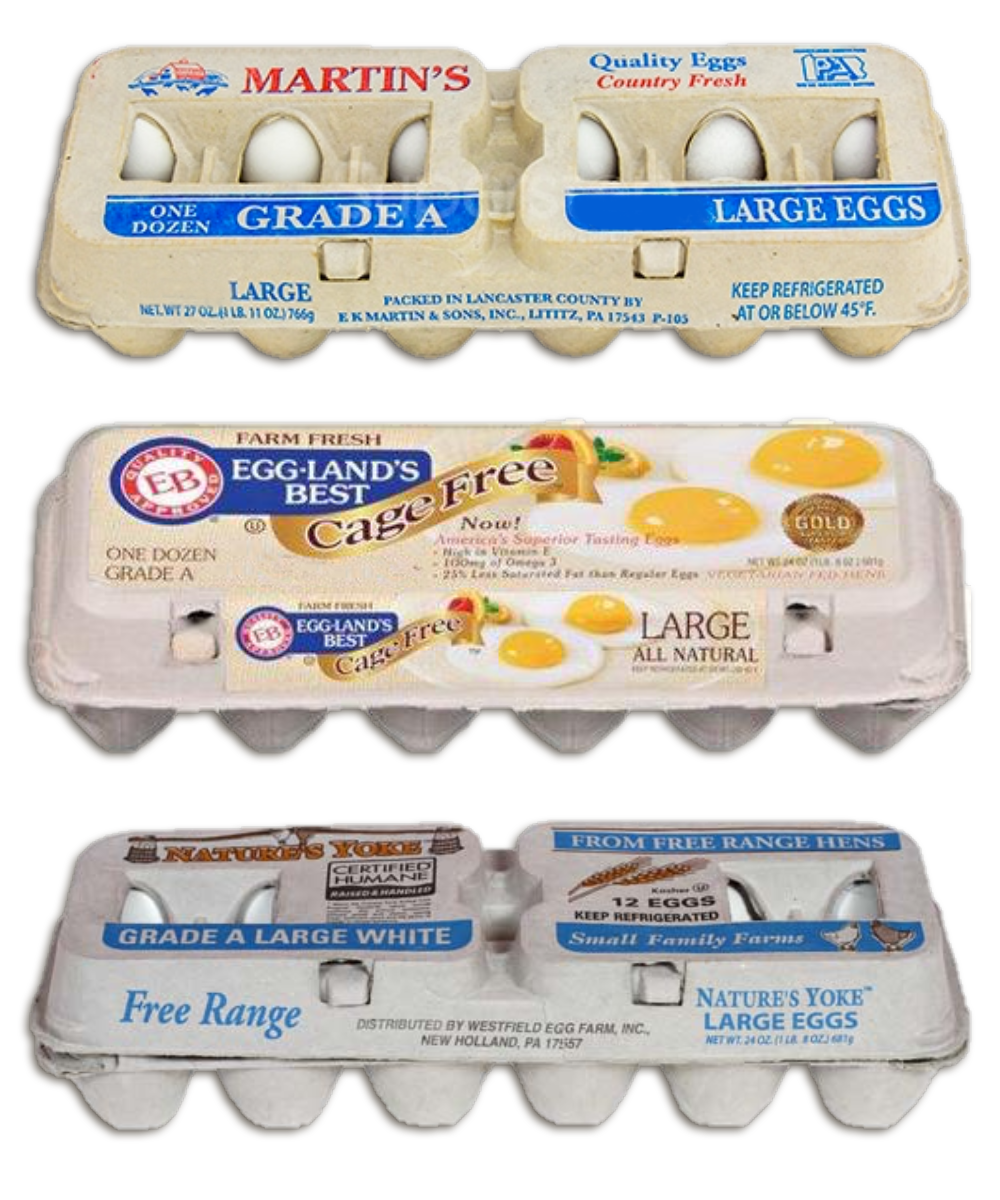
| The price difference between conventional and specialty eggs, such as cage-free and free range, along with other perceptions, may cause some students to have the misconception that the more expensive eggs are higher quality or contain more nutrition. Correct this misconception by clarifying that all eggs contain the same nutrient qualities regardless of shell color or the farm production style used to produce them.6 |
Explore and Explain
Activity 1: Examining Hen Housing Systems
- After completing the Interest Approach, ask students, "After seeing these three egg carton labels, what questions come to your mind regarding the production of eggs on farms?" Allow students to brainstorm the questions they have. List some on the board. Examples could include:
- What does each hen housing system look like?
- Which housing system is "best" for hens?
- Which housing system is "best" for farmers or consumers?
- What is the most humane housing system for laying hens?
- How can I determine what is humane and what isn't?
- Give each student one copy of the Claim, Evidence, and Reasoning in Egg Production handout.
- Introduce the Claim, Evidence, Reasoning Model. Explain that after a question is asked, this model can be used to find a credible answer to a question by using the following steps:
- Claim: State a direct response to the question.
- Evidence: Find reliable information that supports the claim.
- Reasoning: Link the claim to evidence by explaining how the evidence supports the claim.
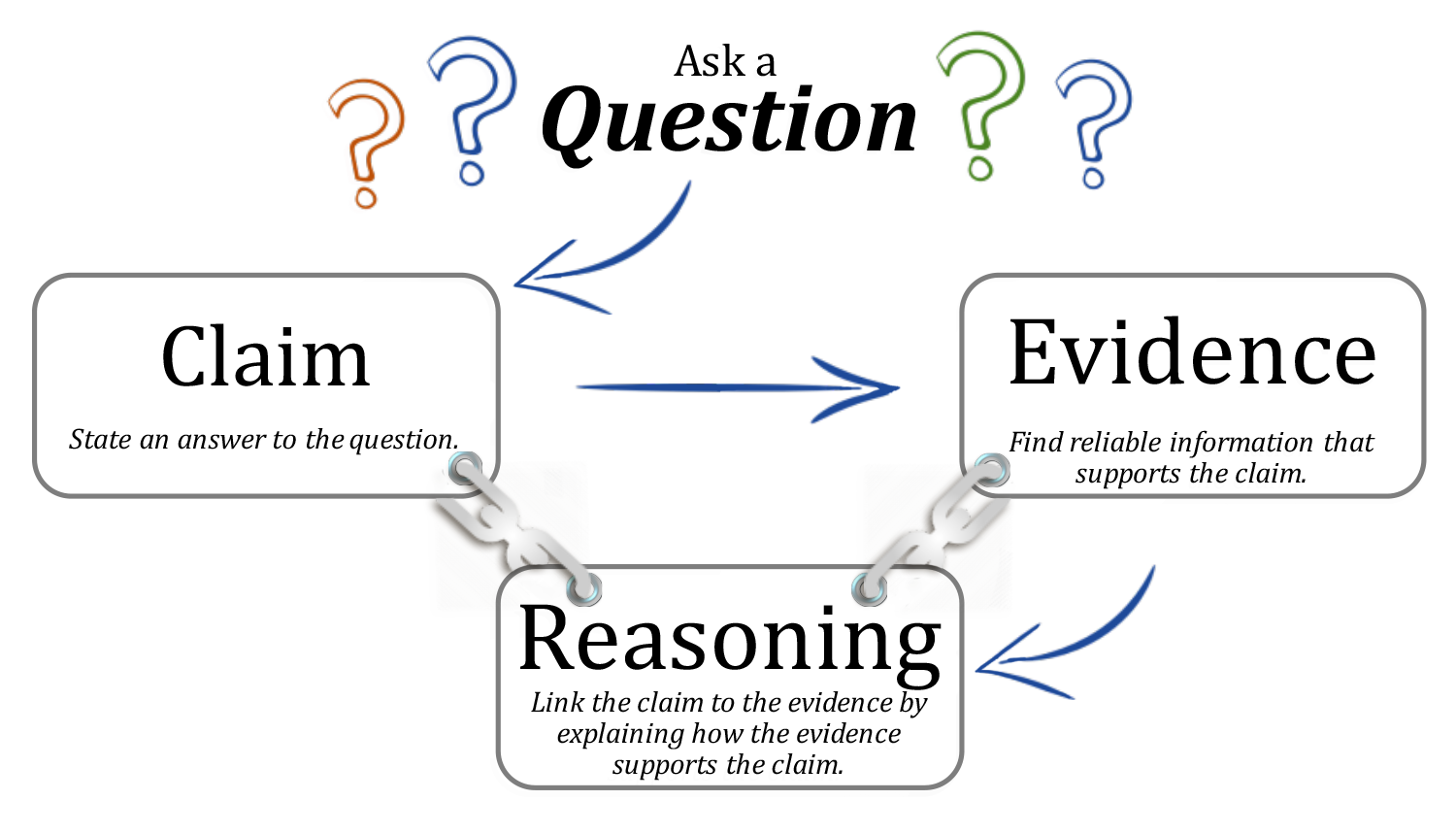
- Instruct students to complete two of the four steps. They should choose one question they would like to answer about the housing of hens and the production of eggs. Next, they will formulate a claim by answering their question. Let students know we will come back to the evidence and reasoning portions momentarily.
- Have students turn to the backside of their handout. Let students know that they will be gathering evidence by learning about each hen housing system. To do that, they will be taking a virtual tour of Burnbrae Farms, a large egg farm in Canada with four hen housing styles. Inform students that although the videos tour a farm in Canada, American egg farms are very similar. Have students watch each video and compare and contrast the benefits and drawbacks for each housing system as they take notes in their graphic organizer. Be sure students recognize that some characteristics they see will be present in all four systems. Those should be listed in the middle. Specific notes on what is different about each individual system should be taken in the corresponding box. At the end of the videos, all five sections of their notes should be filled.
Conventional Hen Housing (3:07)
Cage-free (2:22)
Free Range Housing (2:45)
Enriched Colony Housing (2:59)
- After completing the activity, students should recognize that, when accounting for all factors, each system has both benefits and drawbacks. Each farmer chooses their preference for hen housing systems, and consumers support the markets of their choice when they purchase their eggs.
- Once students have completed the graphic organizer on page 2 of the handout, instruct them to return to the first page of the handout and fill out the "Evidence" and "Reasoning" section to complete the handout.
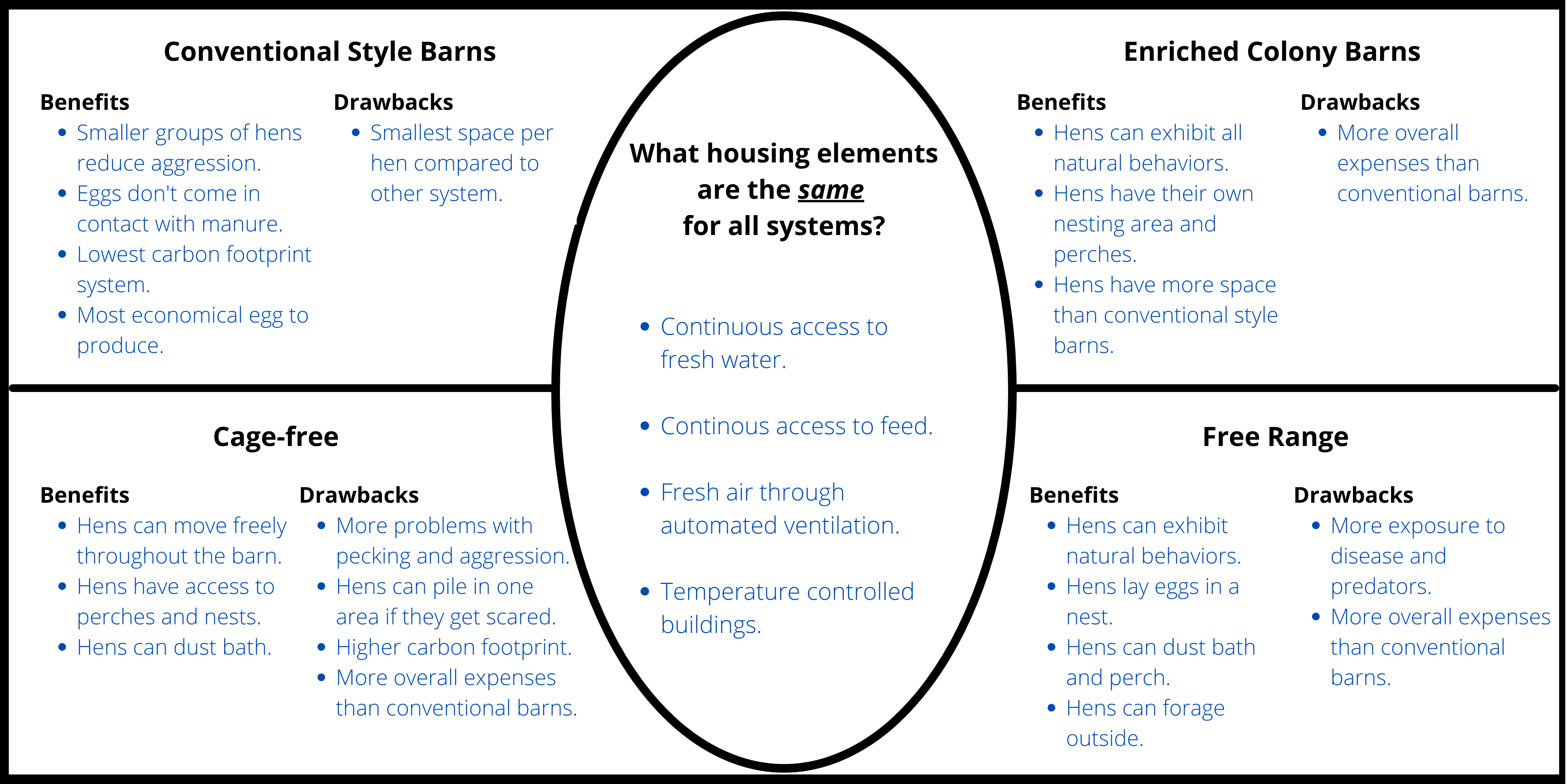
|
Three Dimensional Learning Proficiency: Science and Engineering Practices Asking Questions and Defining Problems: A practice of science is to ask and refine questions that lead to descriptions and explanations of how the natural and designed world works and which can be empirically tested. |
Activity 2: Critically Thinking Animal Welfare
- Ask the question, "What factors are taken into consideration when constructing and designing a barn for laying hens?" Answer the question by showing the video clip, Barns from the American Egg Board's Eggs 101 video. As students watch the video clip, have them list important factors to consider when designing housing for laying hens.
- Project the Critically Thinking Animal Welfare PowerPoint. Using slide 2, point out to students that the different hen housing systems evolved as a result of consumer demand. 20 years ago, there was only one choice of eggs at the grocery store. Following the laws of supply and demand, when consumers perceived that eggs from a specialty system (such as free-range or cage free) were "better" in terms of the welfare of the hens, they were willing to pay more for them, creating a niche market for farmers with different housing systems and farming practices.
- Have students consider the question, "How can the welfare of laying hens be measured?" (slide 3)
- (Slide 4) As students are thinking, ask them to discern or choose the "best" in the following circumstances:
- The best basketball team in a tournament. (The team that scores the most points in the tournament.)
- The high score on a test. (Add up the total score for each student in the class and find the highest number.)
- The largest house lot in a subdivision. (Measure the lots and calculate the square footage or acreage and choose the largest.)
- (Slide 5) Ask students what is similar in each of these scenarios? (They can each be measured and quantified with a number. The comparison is objective [measurable] and simple with only one factor of comparison.)
- (Slide 6) Discuss the difference between objective and subjective forms of evaluation.
- Explain that one way to objectively measure and evaluate the effectiveness and animal welfare of an egg laying system is to perform research (slide 7). Introduce students to the research study performed by Coalition for Sustainable Egg Supply (CSES). Give a brief overview of the research by explaining that three hen housing systems were studied (slide 8) and that the results were compared to the standard housing system in the United States, which is the conventional barn system (slide 9).
- Help students read and interpret the research results of the study. Give examples of objective measurements evaluated in the study.
- Example 1: Hen mortality (slide 10) was measured in the study. Conventional barn hens and enriched colony hens had a similar mortality rate and the cage-free aviary had a higher mortality rate.
- Example 2: Behavior (slide 11), or the hen's ability to exhibit behaviors such as perching, nesting, and dust bathing, were measured in each system. Both the enriched colony and cage-free aviary provided a better environment for natural behaviors than the conventional barn system.
- Give students digital access to the CSES Final Research Results Report or a hard copy of pages 26-35. Instruct students to continue studying the summary infographic for "Animal Health and Well-Being" on page 29.
- Note: If students view the PDF digitally, be sure they are using the page numbers located on the top right-hand corner of each page, not the ones found in the PDF reader, which includes the cover page. Page 29 is used in this step of the lesson. The remaining pages will be used in Activity 3.
- After students have studied the remaining measurements in the report (on page 29), discuss critical thinking (slide 12). Ask each student to determine for themselves what the best farming practices are for the production of eggs in terms of the welfare of laying hens.
- Optional: To complete a CERR model, discuss a "rebuttal" (slide 13). Have students return to the Claim, Evidence, and Reasoning in Egg Production handout from Activity 1 and respond to prompts such as:
- After completing the Evidence and Reasoning stage, was your original claim correct?
- If yes, what evidence confirmed your claim?
- If no, what evidence corrected your misconception?
- After completing the Evidence and Reasoning stage, was your original claim correct?

Activity 3: Design a Hen Housing System
The following activity is designed in stages allowing teachers to complete the stages based on their available time, resources, and curriculum needs.
Stage 1: The Plan
- Introduce the final activity of this lesson as a challenge. Divide students into groups of three students. Give each group one copy of the Hen House Engineering Challenge activity sheet. Explain that they are being put to the task of designing and engineering a housing system for a commercial egg farm. Students will be putting to use everything they have learned so far.
- Discuss the graphic on the front page of the activity sheet. Explain that egg producers have several factors to consider as they aim to produce a safe and healthy food source in an affordable manner while providing the best care to the hens all while considering the environmental sustainability of the farm.
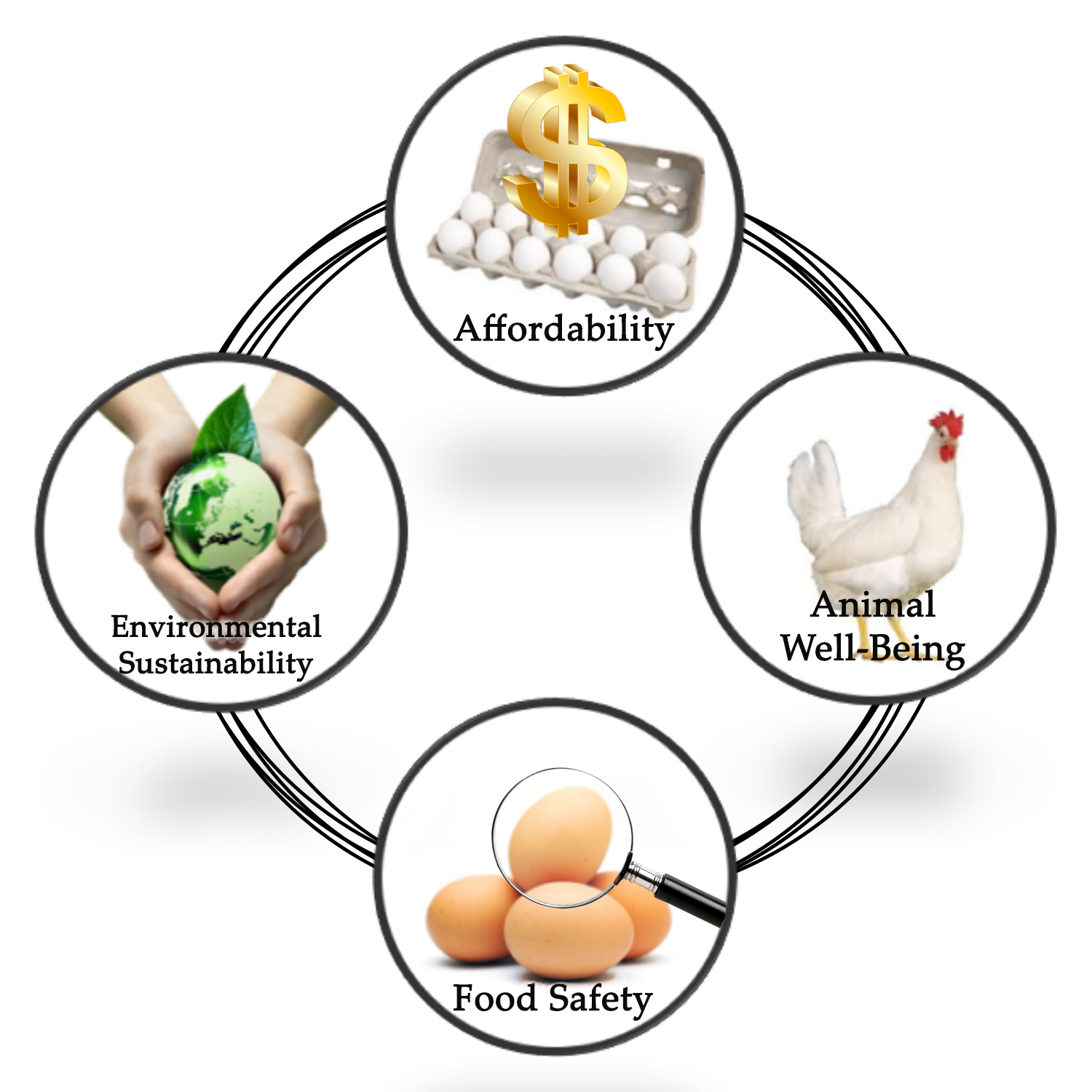
- Assign students to complete the activity sheet by creating a complete written description of their hen housing design. Students can use the following resources for guidance and research:
- CSES Final Research Results Report. Any of the report can be used, but pages 26-35 include the best summaries and user-friendly graphics.
- Burnbrae Farms: Where Our Hens Live YouTube Playlist. In addition to the videos used in Activity 1 of the lesson, students will find videos about using solar power, manure management, hen care, feed and water, and how pecking order impacts the social order of hens.
Stage 2: Build a Model
- Give each group of students supplies to build a model of their hen housing plan.
- Begin with the exterior structure of the model barn. Exact measurements may vary, but the basic box structure shown below can be used as a starting point.

- Once the cardboard is cut out, have students fold the side walls up and tape. Fold the cardboard for the roof in half to give the roof a pitch and attach with tape on one side. This will allow the roof to be lifted to see inside.
- Tip: Students may also leave one wall of the barn lying flat to allow easier access as they construct the interior portions of the barn.

- Tip: Students may also leave one wall of the barn lying flat to allow easier access as they construct the interior portions of the barn.
- Encourage creativity and ingenuity to best illustrate their idea for the housing of hens. Begin with supplies such as cardboard, card stock, clear tape, markers, etc.
Stage 3: Basic Circuits
To continue the engineering portion of the hen house design, students need a basic knowledge of electrical circuits. If students do not have this prior knowledge, complete the Introduction to Circuits activity. In the activity they will complete the Paper Circuits worksheet and build four circuits using copper tape, LEDs, and a 3V coin cell battery. If they already have a basic understanding of electrical circuits, skip to the next stage.
Stage 4: Add Lights and Ventilation
- Remind students of the importance of ventilation and lighting in hen housing. Lighting has a big impact on egg production, and ventilation plays a large role in overall hen health. The next step to engineering their hen housing is to equip it with lights and a fan.
- Give each group of students supplies to add supplemental lighting and ventilation to their hen house.

Stage 5: Program Automated Lights and Ventilation (optional)
- In a modern hen housing system, fans turn on automatically to maintain air quality and lights are programmed to turn on and off to simulate a 16-hour day year-round. Have students use a microcontroller to program lights and a fan to run automatically in their hen house model.
- Connect the copper tape from the hen house to the microcontroller using an alligator clip with a pigtail connector or a more permanent connection can be made by soldering jumper wires to the copper tape on the hen house.
- If you are new to using Arduino microcontrollers, consider purchasing a SparkFun Inventors Kit or an Arduino Uno Starter Kit to learn the basics of using a microcontroller.
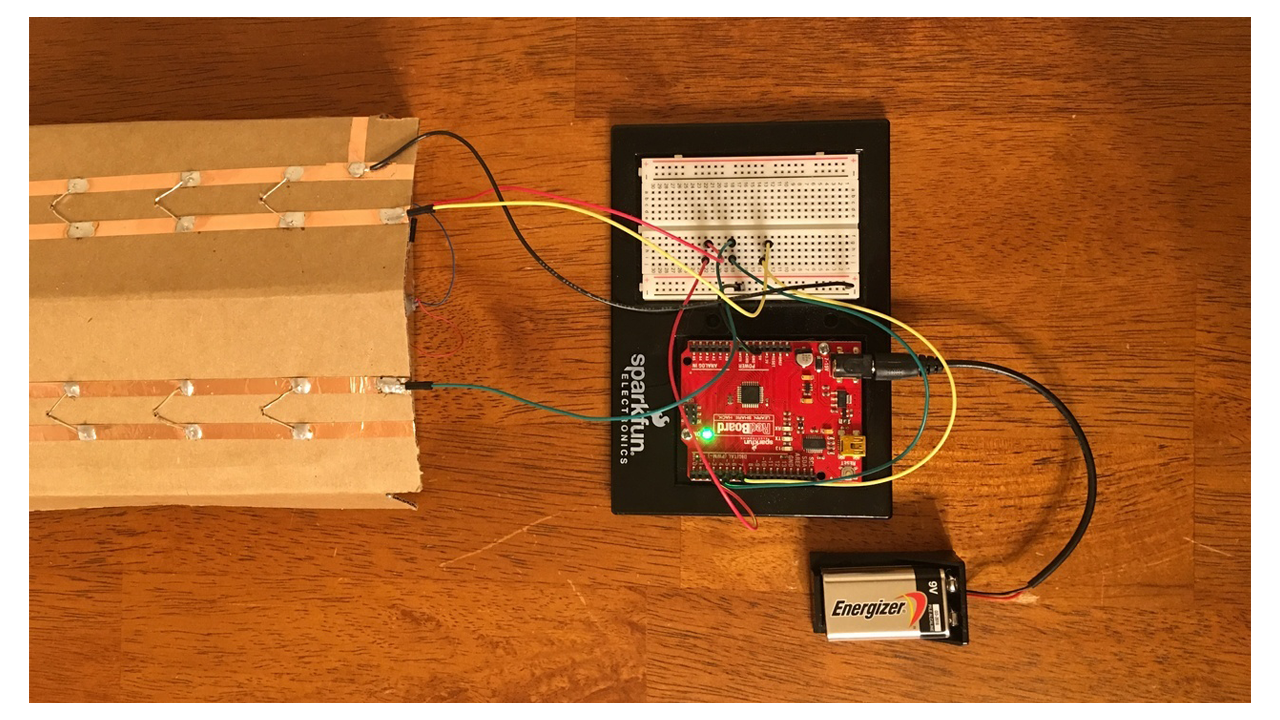
|
Three Dimensional Learning Proficiency: Disciplinary Core Ideas Defining and Delimiting Engineering Problems: Criteria and constraints also include satisfying any requirements set by society, such as taking issues of risk mitigation into account, and they should be quantified to the extent possible and stated in such a way that one can tell if a given design meets them. |
Elaborate
-
Spotlight a career in agricultural engineering by viewing the video, Agricultural Engineering by ThinkTVPBS. Discuss engineering careers in the context of the egg laying industry. Discuss the role of engineering in developing automated systems for temperature control, ventilation, manure management, egg collection, etc.
-
Hold a class discussion about the value and impact of scientific research. Ask students, "How valuable is the research study conducted by the Coaltion for Sustainable Egg Supply?" (Used in Activities 2 and 3) Discuss some limitations of research. Read the last paragraph found on page 3 of the research report which sets in context the results of the research study.
-
Learn more about photoperiodism and how it impacts egg production using the lesson plan, Photoperiod Phenomena.
-
Dig deeper into the business and marketing aspect of egg production with the lesson plan, Weighing in on Egg Labels, Supply and Demand.
-
Take a virtual reality field trip to an egg farm that uses enriched colony housing by viewing the 360 video Farm Food 360 Tour - Egg. This video is best viewed using a virtual reality (VR) viewing device, but can also be viewed on a computer, smart phone, or tablet without a VR viewer. VR viewers are available for purchase at agclassroomstore.com.
Evaluate
After conducting these activities, review and summarize the following key concepts:
- Scientific research can be used to objectively evaluate the efficiency, sustainability, and animal welfare practices found in agricultural settings such as on an egg farm.
- Consumer choices influence food production systems. As consumers provide demand for eggs labeled with specific hen housing systems, farmers respond and provide a supply.
- Each style of hen housing has both benefits and drawbacks when evaluated from multiple perspectives, such as food safety, environmental sustainability, animal well-being, and affordability.
- Food labels, such as "cage-free" or "free range," impact consumer choices.
Sources
- https://www.incredibleegg.org/about-us/industry-data
- https://unitedegg.com/facts-stats/
- https://www.cnbc.com/2017/03/22/egg-makers-are-freaked-out-by-the-cage-free-future.html
- http://content.time.com/time/health/article/0,8599,2002334,00.html
- https://www.incredibleegg.org/about-us/us-egg-farming-history
- https://www.eggnutritioncenter.org/science-education/nutrients-in-eggs/nutritional-differences-different-types-eggs/
Recommended Companion Resources
- 360 Agriculture Virtual Reality
- All About Eggs
- Arduino Controlled Relay
- Eggs 101: An Egg's Journey from the Farm to Our Tables
- Hen House Prototype
- How to Read Food Labels, From Free-range to Fair Trade
- Introduction to Circuits
- Labels Unwrapped
- Paper Circuits
- Two Truths and a Lie
- VR Viewer
- Virtual Egg Farm Field Trips
Author
Organization
| We welcome your feedback! If you have a question about this lesson or would like to report a broken link, please send us an email. If you have used this lesson and are willing to share your experience, we will provide you with a coupon code for 10% off your next purchase at AgClassroomStore. |
